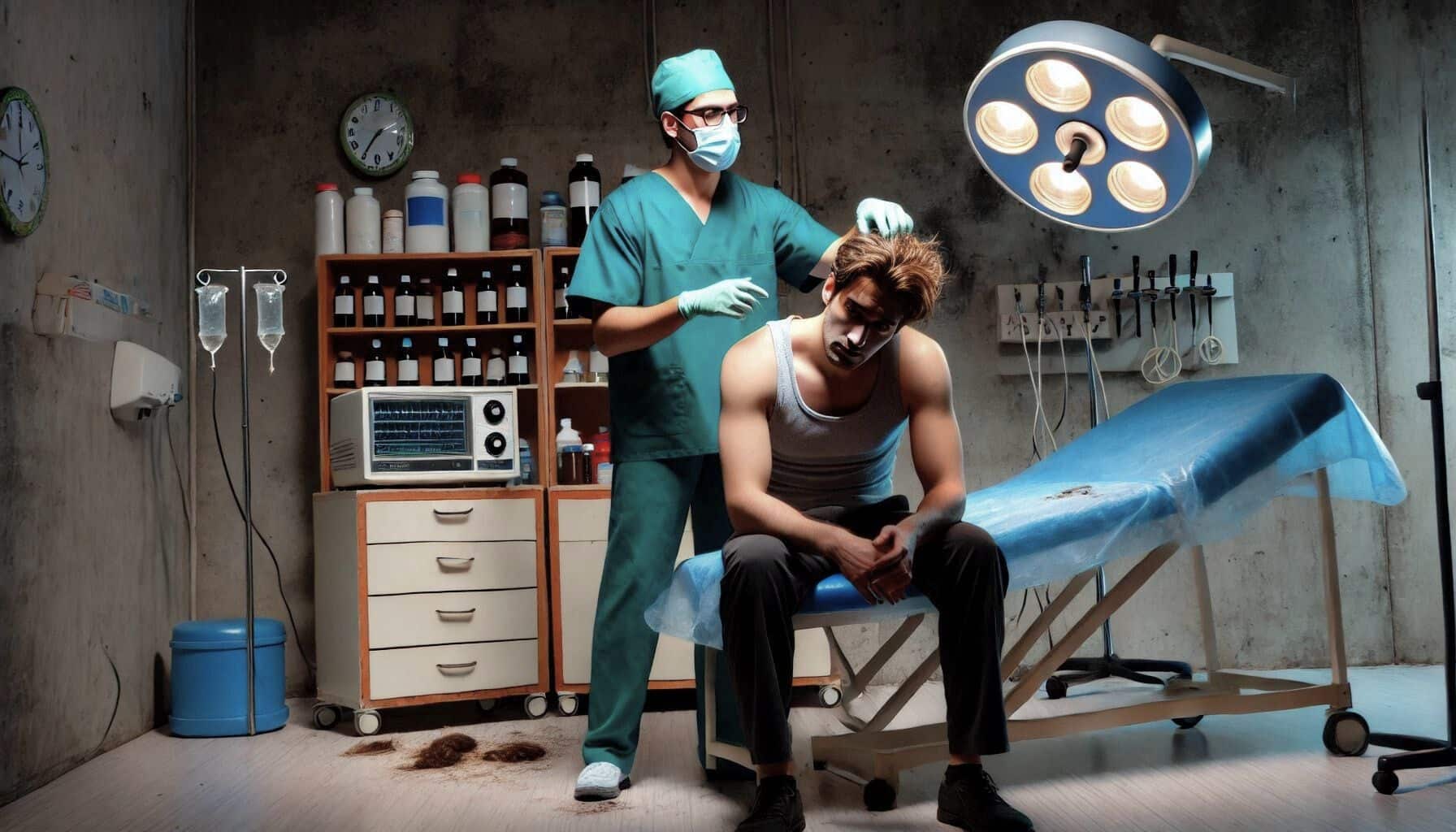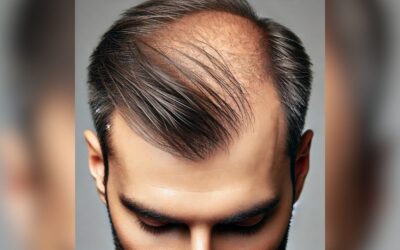
Introduction
Hair transplant surgery can offer a life-changing solution for those dealing with hair loss, promising not just restored hair but renewed confidence. However, there are risks of bad hair transplants, and many have shared hair transplant horror stories that highlight the potential for disastrous outcomes. Not all clinics and hair transplant surgeries are created equal. Choosing the wrong one can lead to disappointing results, additional costs, and even permanent damage. To help you avoid such pitfalls, this comprehensive guide will highlight key warning signs of a subpar clinic, empowering you to make an informed decision and ensure a successful hair restoration journey.
Understanding Hair Transplant Surgery
Hair transplant surgery is a medical procedure designed to combat hair loss by transferring hair follicles from one part of the body to another. Typically, this involves moving existing hair follicles from the back and sides of the head—areas where hair is more resistant to balding—to the thinning or balding areas. The ultimate goal is to restore a natural-looking hairline and improve the overall appearance of your hair. This procedure can be life-changing, offering not just a fuller head of hair but also a significant boost in confidence.
Definition of Hair Transplant Surgery
At its core, hair transplant surgery is a type of hair restoration surgery that involves the meticulous transfer of hair follicles from a donor site to a recipient site. The donor site is usually the back and sides of the head, where hair tends to be thicker and more resistant to hair loss. The recipient site is the area experiencing thinning or balding. This precise process aims to create a natural-looking hairline and fuller hair, making it a popular choice for those seeking a permanent solution to hair loss.
Types of Hair Restoration Surgery
When it comes to hair restoration surgery, there are several methods to consider, each with its own set of advantages:
Follicular Unit Extraction (FUE): This minimally invasive procedure involves extracting individual hair follicles from the donor site and transplanting them to the recipient site. FUE is known for its minimal scarring and quicker recovery time.
Strip Harvesting: Also known as Follicular Unit Transplantation (FUT), this traditional method involves removing a strip of hair-bearing skin from the donor site and transplanting it to the recipient site. While it can result in a linear scar, it allows for the transplantation of a larger number of grafts in a single session.
Robotic Hair Restoration: This cutting-edge method uses a robotic system to extract and transplant hair follicles. The precision of robotic technology can enhance the accuracy and efficiency of the procedure, potentially leading to better results.
Each method has its own set of benefits and considerations, so it’s essential to discuss these options with your surgeon to determine the best approach for your specific needs.
Key Warning Signs of a Bad Hair Transplant Clinic

Lack of Transparency
Transparency is essential when selecting a hair transplant clinic. A reputable clinic will provide clear and detailed information about their procedures, costs, and expected results. If a clinic seems evasive or avoids answering your questions, it’s a red flag. Honest communication is crucial for setting realistic expectations and building trust to avoid a botched hair transplant.
Inconsistent Results in Before-and-After Photos
Before-and-after photos are a valuable tool in evaluating a clinic’s work. Evaluating these photos can help assess hair transplant outcomes by showing the success of the procedure and the surgeon’s expertise. Pay close attention to these images and assess the consistency and natural appearance of the results. Beware of edited or outdated photos. Authentic images should reflect real patient outcomes without excessive retouching. If the clinic’s portfolio looks too polished or selective, ask for more recent or varied examples to get a true sense of their capabilities.
Unrealistic Pricing
While cost is a significant factor, extremely low prices can be misleading. Hair transplant procedures involve a high level of expertise and quality materials, which come at a cost. If a clinic offers drastically reduced prices, it may indicate that corners are being cut—whether through less experienced surgeons, poor technique or outdated techniques. Remember, a hair transplant is an investment in your appearance and confidence; choosing a clinic based solely on price can result in compromised quality.
Evaluating Surgeon Expertise

Board Certification and Experience
The skill and experience of the surgeon are critical to the success of your hair transplantation surgery. Look for surgeons who are board-certified by reputable organizations like the International Society of Hair Restoration Surgery (ISHRS). Certification ensures that the surgeon has undergone rigorous training and adheres to high standards. Additionally, review the surgeon’s portfolio of before-and-after photos and ask for case studies that demonstrate their ability to handle complex cases. Experience and specialized training are essential for achieving successful outcomes.
Modern Techniques vs. Outdated Methods
Hair transplant techniques have evolved significantly over the years. Modern methods, such as Follicular Unit Extraction (FUE) and Follicular Unit Transplantation (FUT), offer superior results with minimal scarring and a more natural appearance. Outdated techniques, like “plug” transplants, can lead to unsatisfactory results and visible signs of the procedure. Ensure that the clinic uses contemporary methods to achieve the best possible outcome.
Researching a Hair Transplant Clinic

Choosing the right hair transplant clinic is a critical step in ensuring a successful hair transplant procedure. Thorough research can help you avoid common hair transplant pitfalls and protect your investment. Here are some essential tips for researching a hair transplant clinic:
Online Reviews and Ratings
Online reviews and ratings can offer valuable insights into a hair transplant clinic’s reputation and quality of care. Look for clinics with high ratings and positive reviews across multiple platforms, such as Google, Yelp, and Facebook. Be cautious of clinics with low ratings or an abundance of fake reviews. Genuine feedback from previous patients can provide a realistic picture of what to expect.
When evaluating a hair transplant clinic, keep an eye out for the following red flags:
Low Prices: If a clinic offers prices significantly lower than others, it could be a sign of a low-quality procedure or even a scam. Quality hair transplant procedures require expertise and high-quality materials, which come at a cost.
Lack of Credentials: Ensure the clinic has a qualified and experienced hair transplant surgeon on staff. Check for board certifications and memberships in reputable organizations like the International Society of Hair Restoration Surgery (ISHRS).
Poor Online Reviews: A large number of negative reviews can indicate consistent problems with the clinic’s services. Pay attention to recurring issues mentioned by multiple reviewers.
Unrealistic Promises: Be wary of clinics that guarantee specific outcomes or promise unrealistic results. Hair transplant success can vary based on individual factors, and no reputable clinic can guarantee a particular result.
By conducting thorough research and choosing a reputable hair transplant clinic, you can avoid hair transplant regrets and ensure a successful hair transplant. Protect your investment by making an informed decision and selecting a clinic with a proven track record of successful hair transplants.
Signs of Poor Quality and Failed Transplants

Poor Hair Growth
A successful hair transplant typically shows noticeable growth within a few months, with full results taking up to a year. If you see no significant progress after this period, it may indicate issues with the procedure. Poor growth can result from inexperienced surgeons, outdated techniques, or improper graft placement. Proper placement of transplanted hair follicles is crucial for their success, as it ensures they heal and integrate well, promoting healthy growth. A reputable clinic should provide a realistic timeline for hair growth and support you throughout the process.
Visible Scarring
Bad hair transplants can lead to visible scarring, especially in the donor site. Modern techniques like FUE are designed to minimize scarring, while older methods like strip harvesting can result in noticeable scars. Ensure that your surgeon is proficient in minimizing scarring and uses advanced techniques to achieve the best results.
Donor Site Management
Proper management of the donor site is crucial for a successful hair transplant. A high-quality clinic should handle the donor hair and area with care, ensuring minimal visible scarring and optimal healing. Discuss your concerns with the clinic and confirm their approach to preserving the donor site’s integrity.
Addressing Potential Complications

Infection and Healing Issues
Post-operative infections and healing issues can affect the success of your hair transplant. Proper aftercare is essential to minimize these risks. Ensure that the clinic provides detailed post-operative care instructions and support to help you manage potential complications. Following these guidelines will improve your chances of a successful outcome and reduce the risk of infection.
Repairing Botched Transplants
If a botched hair transplant occurs, it may require additional corrective procedures, which can be costly and complex. Common issues include poor hair grafts survival, unnatural hair angles, and permanent hair loss. Consult with a skilled professional who specializes in corrective procedures to address any issues and work towards a satisfactory outcome.
Medical Tourism Considerations

Medical tourism can be appealing due to lower costs, but it carries significant risks. If you’re considering traveling abroad for your hair transplant, be aware that unregulated clinics may perform subpar hair transplantation, leading to complications such as scarring and an unnatural appearance. Ensure they have proper certifications, a strong reputation, and a history of successful outcomes. Research patient reviews and verify the clinic’s credentials before making any commitments.
Enhancing Results with Exosomes & Platelet-Rich Plasma Therapy
Platelet-Rich Plasma (PRP) Therapy
Platelet-Rich Plasma (PRP) therapy can significantly enhance the results of a hair transplant. PRP involves injecting platelet-rich plasma into the scalp, which helps stimulate hair growth and improve the healing process. The plasma, derived from your own blood, contains growth factors that promote the survival and vitality of transplanted hair follicles. PRP therapy can be a valuable addition to your hair restoration plan, potentially leading to better overall outcomes. Discuss with your clinic the benefits of PRP and how it can be incorporated into your treatment.
Exosome Therapy
Exosome therapy is an emerging technique that also holds promise for enhancing hair transplant results. Exosomes are small extracellular vesicles that play a crucial role in cellular communication and regeneration.By applying exosome therapy, clinics aim to boost hair growth and improve the health of hair follicles by delivering regenerative molecules directly to the scalp. This therapy can complement PRP and traditional hair transplant procedures, providing an additional layer of support for optimal results. If you’re considering this cutting-edge option, make sure to consult with your clinic about its suitability for your specific case.
Conclusion
Selecting the right clinic for your hair transplant is crucial for achieving a successful procedure and avoiding the frustration of a botched transplant. By being aware of the warning signs and thoroughly researching your options, you can make an informed decision and set yourself up for a positive hair restoration experience. Ask questions, review credentials, and choose a reputable clinic with experienced surgeons to perform hair transplant surgery and ensure the best possible results. With careful consideration and the right clinic, you can confidently get fuller, natural-looking head of hair.












